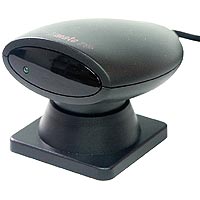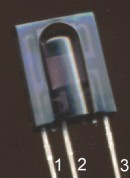|
Generic SIR COM IrDA device (Tekram IR-210) Supported hardware 1. External IrDA port (Tekram IR-210), connected to COM port. 2. Integrated IrDA port (notebook for example) 3. RX device. It can be any IR receiver, connected to IrDA port on motherboard. Available chips: TSOP1836, IS1U60L, GP1U52X, SFH506-36,TK1833, ILMS5360, TK69 649, TFMS 5NN0
IrDA connector pinout on motherboard is usually one of the following (it would be better, to read the motherboard manual):
One of the best way to connect IR-reciever and motherboard - is to use CD-ROM Audio cable, or serial (COM) mouse cable. You should only swap some contacts. REMEMBER! RX device is not the same as IrDA. All IrDA receivers will work badly, because they haven't bandpass & demodulator. They are not intended for remote control. Absolutely NO WARRANTY. See also DCD, UIR. Supported remote control units Pulse-length and Bi-pahse modulation not supported. Tested: JVC (successfully), Drivers If you're using external COM IrDA device (Tekram IR-210), you need remove IrDA drivers or simply reconnect device to free COM port. If you're using RX device or internal IrDA: FIRST, you should disable standard IrDA drivers, which are installed after enabling IrDA.
* Many thanks to http://cmail.info.kuzbass.net/~nav/ If you're using Windows 9x, or Windows ME find
msports.inf in your Windows\Inf directory and edit it:
Uncomment/add the following lines:
2) In section [Strings] uncomment/add the following lines:
For Windows ME you should also delete irmini.inf (or, better rename to irmini.bak for example) For Windows 2000 I used such a method
to delete standart drivers:
and replace
to
2) Add to msports.inf to section [Std]:
to section [Strings]:
add
to section [ControlFlags] For Windows XP I just used .inf files
from Windows 2000. You may try to edit XP .inf files same way as
it described above - it should work. ONLY NOW enable IrDA in BIOS. Usually
you should also enable RX inverting. Usually, it's useful to disable FIFO buffers for Ir serial port (it is in system properties). Note: Run plugin setup for choice of COM port and see / define button names. Events: Default type: "REMOTE" Wait before repeat: 300 ms Actions: none Example: Ir210 = Load( "Ir210\Ir210.dll", "REMOTE" ) main = group( enabled ){ | |||||||||||||||||||||||||||||||||||||||||||||||

 Pinout:
Pinout: